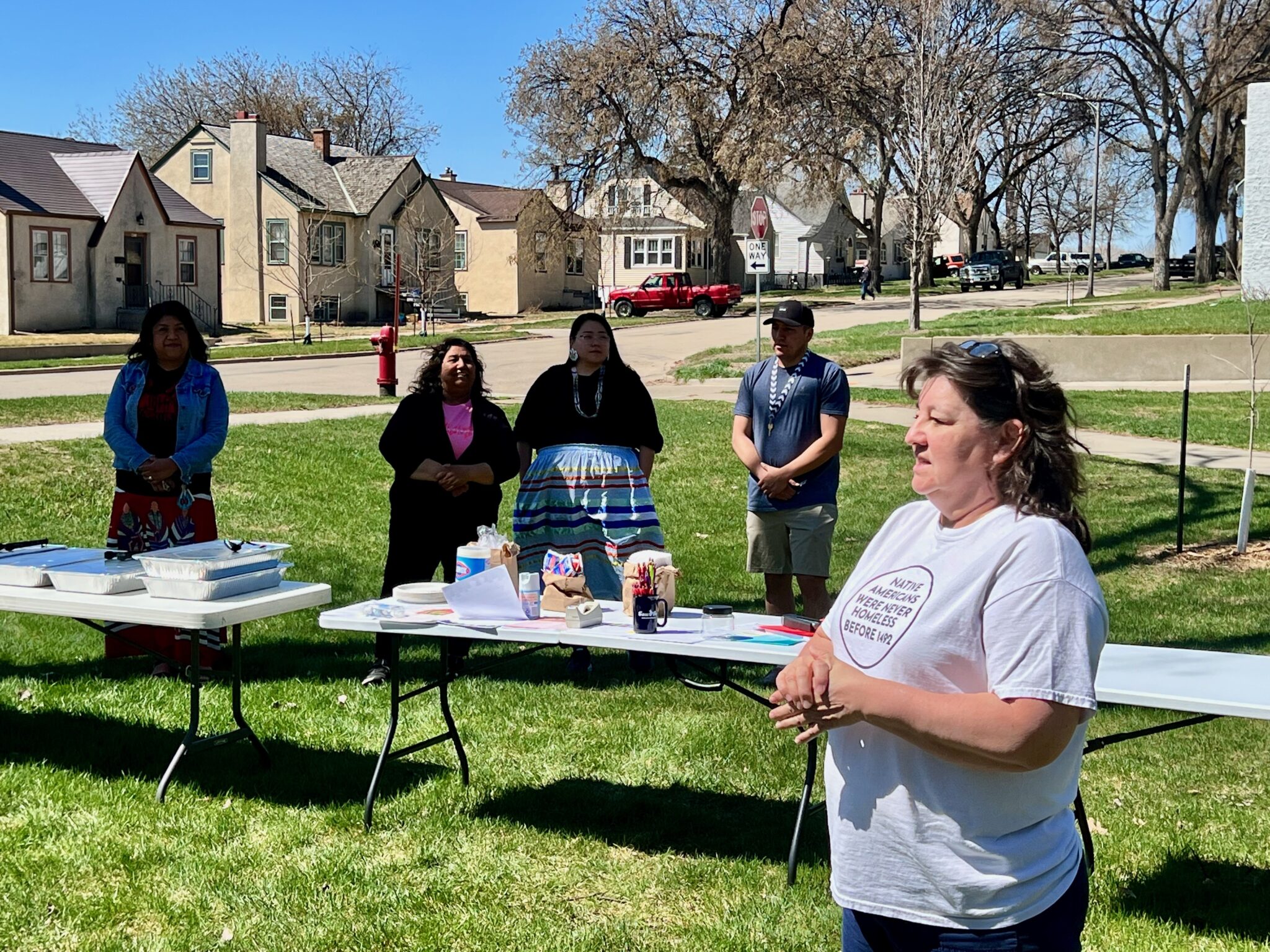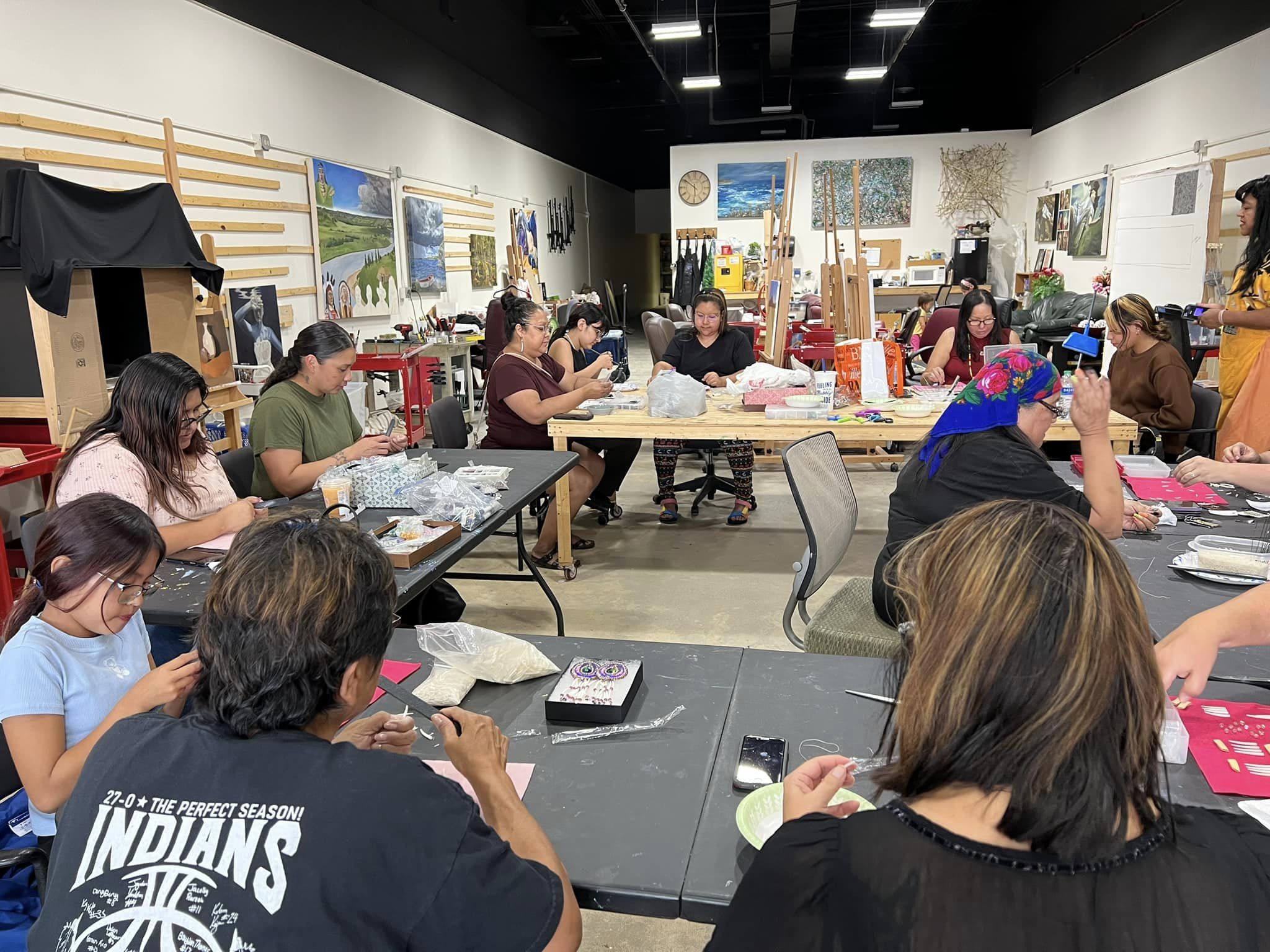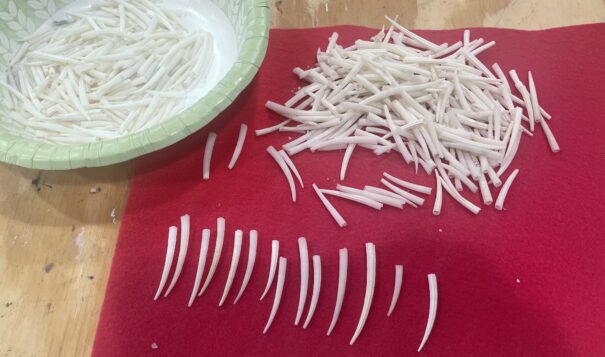This story was originally published by Buffalo’s Fire, the independent news platform run by the Indigenous Media Freedom Alliance, a Native-led, Native-woman founded non-profit. Their focus is to raise the visibility of Native peoples through storytelling that reflects the beauty of Indigenous language, arts, culture.
A dozen women sit around a table at an art studio, meticulously filing dentalium shells to make earrings during one of many cultural workshops that the Sacred Pipe Resource Center offers.
The Native artist-led event, advertised as a “Shell Sesh”, drew a full house on the evenings of Aug. 22 and 24. With a third session booked for Aug. 29, organizers received a warm reception for promising a fourth class this fall.
Dentalium shells “represent empowerment and purity,” workshop leader Shawna Fricke told Buffalo’s Fire. “I like being together with all the ladies and being a community. We talk, and learn, as well as get to know each other.”
Empowerment and a sense of community are just what the Sacred Pipe Resource Center, SPRC, aims to foster in the Mandan-Bismarck area, according to SPRC’s executive director Cheryl Kary. Through a variety of cross-cultural activities, the center aims to provide Native people a safe space to meet others and expand their circles.
Kary founded the organization about 17 years ago, in response to Bismarck-Mandan residents who felt the need to unite the local urban American Indian community as well as nearby populations.
“We know that the urban tribal population is often called the invisible population, because we’re isolated and spread out over the city, so it’s hard to come together as a community,” Kary told Buffalo’s Fire.

The Sacred Pipe Resource Center exists “to serve the American Indian population by creating partnerships and positive collaborations based on the shared experiences of those living in this region.” The center takes its name from the meaning behind the pipe as a tool for sharing spirit, truth, reconciliation and peace.
The SPRC received its 501(c)(3) status as a tax-exempt nonprofit in 2014, but it has been working in the community since 2007. Organizers have been providing opportunities to learn more about culture, jobs and advocacy. In 2022, SPRC expanded its reach when it joined three other nonprofits to help the Bush Foundation provide some $1.2 million in grants to Native nonprofits in North Dakota, South Dakota and Minnesota.
The center puts its heart into community work and aims to get people involved – even if only one or two show up, Kary said. “Sacred Pipe really tries to bring a sense of community and also to get people active in their communities to make the changes that they want to see.”
Throughout 2023, the center offered summer youth events, including “Leave the Couch.” It was a series of activities encouraging teens and kids to get moving via rollerskating, paintball and horseback riding.
For a “Tiny Tots” event this summer, the center provided materials to make outfits that children could wear during powwows and other cultural events. A recent back-to-school event gave students gift cards to clothing stores after the SPRC heard from parents that clothing had become hard for the kids to afford.
Cheryl Kary, Executive Director“Sacred Pipe really tries to bring a sense of community and also to get people active in their communities to make the changes that they want to see.”

Yet, “it’s not just about giving things away,” SPRC board member Michelle Provancial, a Lakota member of the Rosebud Sioux Tribe, told Buffalo’s Fire. Kary’s approach is to find what “will peak peoples’ interests by offering things that are a little out of the box,” said Provancial. “She encourages them to think.”
Among the center’s most popular activities is bingo. At one event, the SPRC used the game to teach attendees about civic engagement and the voting process. After each round of bingo, participants could win prizes for demonstrating comprehension.
According to Kary, one of the game events led to advocacy. Some participants later took part in a letter-writing campaign, bringing together their voices to make change. Other center activities include a Heart of the Nation Task Force, which was formed to address local concerns about the victimization of American Indian women in the Bismarck-Mandan area.
Meanwhile, the ongoing dentalium earring workshops illustrate the center’s commitment to preserving tribal arts. “There are too many people who aren’t aware of the traditional activities that are available to them,” Provancial said.

For their part, Shell Sesh facilitators Fricke and Emma Goodhouse want to give Indigenous women a space to connect and create together. Fricke is the artist in residency at the SPRC. Part of her job is to promote social justice through art, emphasizing Native identity. Goodhouse is a collaborator at Native Artists United, a local cooperative guild they started.
Putting away a pair of earrings that she was in the process of beading, Valerie Siqueiros, a citizen of the Cheyenne River Sioux Tribe, said she is new to making dentalium jewelry. She found out about the event through the SPRC Facebook page and wanted to share the experience with her daughter, who is about to begin middle school.
“I’ve never made earrings like this before so I thought it would be something fun for me and my daughter to do,” Siqueiros said.
For Kary, this is an example of a culture of inclusion that is imperative in responding to Native needs. “We really try to do things with and to work on behalf of every individual,” she said.
The Sacred Pipe Resource Center’s Dentalium ‘Shell Sesh’ is part of We the Many, a program that supports communities in the creation of their own unique artist residency experiences, encouraging the exchange of voices, cultures, and ideas relevant to each community context. We the Many is a project of Arts Midwest with generous support from the Mellon Foundation and in partnership with the North Dakota Council on the Arts.
